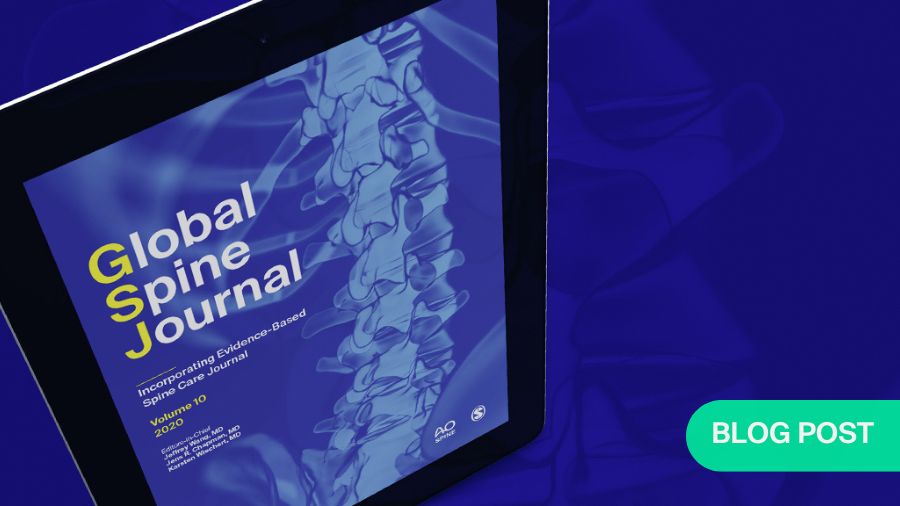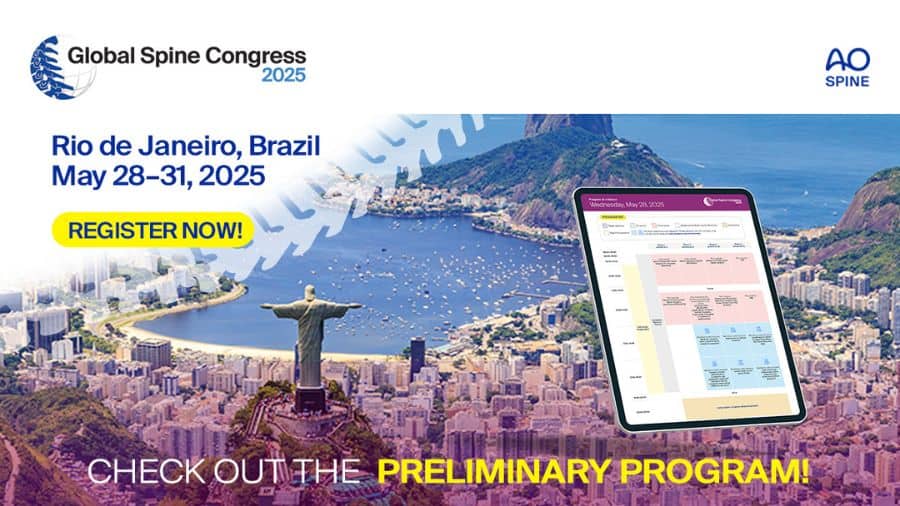The Gold Standard for scientific journals: What you should know about the Impact Factor
BY DANIELLE LIEBERMAN

The Impact Factor is a metric that is the gold standard for judging the quality and impact of a scientific journal. The Impact Factor is a metric calculated and distributed by Clarivate Analytics. It represents the average citation rate of a journal and is used throughout the academic and publishing industry and is an indicator of a journal’s quality and validity. Here, Managing Editor Danielle Lieberman from AO Spine’s official scientific publication, Global Spine Journal (GSJ), explains why it still pays to be mindful of the impact factor when deciding where to publish your research.
Many funders and institutions require that their researchers publish in journals with an Impact Factor, and they can’t even consider journals that are not ranked.
How does the Impact Factor indexing work?
Clarivate calculates Impact Factors for journals that are listed in their journal indexes including the Social Science Citation Index (SSCI), Science Citation Index Expanded (SCIE), Arts and Humanities Citation Index (AHCI), and Emerging Sources Citation Index (ESCI). The impact factors for the previous year are always released at the end of June. For example, the impact factor for 2023 will be released in June 2024. Journals don’t automatically receive an Impact Factor: there is a rigorous and competitive application process. If it seems like a journal doesn’t have enough citations or isn’t distinguishable from other journals in the field, then the application will be rejected.
GSJ was accepted for an Impact Factor in 2019 and currently has an Impact Factor of 2.4 for 2022.
Clarivate puts journals into indexes based on the journal’s aims, scope, and breadth. These categories are chosen by Clarivate. GSJ was applied to the Impact Factor as an Orthoapedics Journal per Clarivate’s instructions, but when the application was accepted, they indexed GSJ in the Neurology index. Journals can be indexed in more than one category if Clarivate deems it appropriate. They look to see which category most of the citations are coming from, and then if there is a secondary category where many of the other citations are coming from as well.
The Impact Factor process and calculation is quite opaque. Nobody knows the full breadth of the data that Clarivate collects because that is kept confidential. The publisher can calculate an “unofficial” impact factor using the basic formula that is available, but the actual Impact Factor may be different due to the confidential nature of the calculation and the official number won’t be known until the release.
“Unofficial Impact Factors” are calculated by dividing the number of citations by the number of “citable items” published. It uses articles published in the two years prior to the Impact Factor year and citations to those articles in the Impact Factor year. For example, the 2023 Impact Factors (which will be released in June 2024) will take the number of 2023 citations to articles published in 2021 and 2022 and then divide that number by the number of citable items published in 2021 and 2022. Citable items are certain manuscript types a journal publishes, not all manuscript types are included. In this calculation to decide the number, there is a numerator and a denominator. The numerator is citations to any article a journal publishes. The denominator is only “citable items”. Citable items are typically Original Research, Reviews, Conference proceedings, and Case Reports (GSJ no longer publishes case reports). Commentaries and Editorials are usually not citable items, but they can receive citations.
What is a good Impact Factor?
In the world of scientific publishing citation trends vary by category, so what counts as a “good” Impact Factor is not so much the number itself as the ranking of the journal in its subject category. The rankings are divided into 4 quartiles. So, being ranked in the 1st and 2nd quartiles is considered excellent.
Global Spine Journal is currently ranked in the 2nd quartile.
Recently Clarivate made changes to the way they calculate the Impact Factor. Previously, it was calculated in this format with three decimal points, X.XXX and now it will only be calculated as such with one decimal point, X.X, which means that journals can now tie. Also, previously articles were calculated based on print publication dates, but now the online publication date or first publication date is used which has made the denominators larger because the OnlineFirst queue is now included along with the issues. This has caused a slight dip in the scores for many journals, but they are expected to level out again in the next few years. GSJ’s Impact Factor has already been rising again since the change was made. The reason for this is unclear, as Clarivate also remains opaque in everything that they do. However, they have stated that they are trying to de-emphasize the Impact Factor, so that might be the reason for some of these changes.
Once you are indexed, even if your number goes up and down, you will stay in the index and won’t be removed, however there are a few exceptions. If a journal has a self-citation rate that is too high (above 15%), the journal will be investigated and may be suppressed. This can include using a self-citation stacking strategy where one or a few articles have been used to artificially inflate the Impact Factor between journals, where two or more journals have agreed to cite each other more than is normal, these are called citation cartels.
Suppressions can be temporary if the concern is addressed, and they can be re-instated after 1–2 years. A journal can be delisted completely if they consistently have a low citation rate (bottom of the category for a few years in a row), if they have ethical issues, numerous reports of peer review fraud, are seen to be coercing citations from authors/editors/members and/or are publishing articles that do not match the journal’s scope.
Why should you still look at the Impact Factor?
The Impact Factor is not the only index in the field. There is also PubMed, which includes PubMedCentral and MEDLINE. Being listed in either of these often meets certain requirements for funders and demonstrates to the public that it is a good journal with good visibility. SCOPUS is another important index that has a number of metrics, and their own CiteScore although it is not given the same importance as the Impact Factor.
The Impact Factor is used as the main metric of a journal’s impact in its field and as a measure for academic success. Investigators doing high-quality research will seek to publish in journals with high Impact Factors, which has over time influenced research practices. There have been movements to try to de-emphasize the importance of the Impact Factor, as other factors contribute to a journal’s merit, but for the foreseeable future, the Impact Factor will continue to be seen as the top index.
About the author:
Danielle Lieberman has been the Managing Editor and Project Manager of Global Spine Journal for 10 years. As Managing Editor, Danielle oversees all manuscripts, projects, and strategic planning. From 2019–2023 she also served as the Managing Editor for Craniomaxillofacial Trauma and Reconstruction.
Danielle has worked in the field of Orthopaedic Surgery since 2012, previously serving as Office Manager in the Department of Orthopaedic Surgery at UCLA. Danielle is a graduate of the University of Wisconsin-Madison in the United States. She currently resides in Los Angeles, California.






